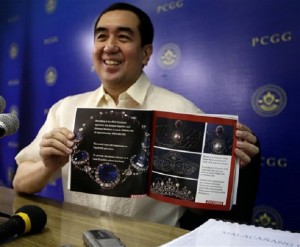
Andres Bautista, chairman of the Presidential Commission on Good Government, which is tasked with recovering the alleged ill-gotten wealth of the late dictator Ferdinand Marcos and his family, shows a catalog of a seized jewelry collection belonging to the Marcoses at a news conference Tuesday, Jan. 14, 2014, in Mandaluyong. AP
MANILA, Philippines—The wife and daughter of the late dictator Ferdinand Marcos are opposing the forfeiture in favor of the state of a collection of around 300 pieces of jewelry that had been left behind in Malacañang when the Marcoses fled during the 1986 People Power Revolution.
In a motion filed in a special division of the Sandiganbayan, Imelda Marcos, the dictator’s widow, and daughter Irene Marcos-Araneta asked the antigraft court to reverse its Jan. 13, 2013, resolution ordering the forfeiture of the collection.
They said the forfeiture order was not justified and proper under Republic Act No. 1379—an act declaring forfeiture in favor of the state of any property found to have been unlawfully acquired by any public officer or employee—because they had not been given enough time to challenge it.
The forfeiture would be tantamount to depriving them of their property without due process of law, they said.
They also asked the court to dismiss the government’s motion for summary judgment in the civil case, insisting that the court had no jurisdiction over the case as it had long been terminated and executed.
The jewelry collection, called the Malacañang collection, is part of a bigger Marcos hoard, which includes tiaras, necklaces, brooches, earrings and belts studded with diamonds and other gems, that has been stored in the vaults of the Bangko Sentral ng Pilipinas since it was confiscated in 1986.
They are divided into three caches according to where they were found: the Malacañang collection of around 300 pieces that was left behind after the Marcoses fled the Palace; the Hawaii collection consisting of 400 pieces, which was seized by the US Bureau of Customs upon the Marcoses’ arrival in Hawaii; and the Roumeliotes collection of 60 major pieces that Imelda’s Greek accomplice, Demetriou Roumeliotes, tried to spirit out of the country a few weeks after the ouster of the dictator.
Only the Malacañang collection has been declared forfeited by the court. No judgment has yet been handed down on the two other collections.
The Roumeliotes collection has by far the most valuable pieces, according to the Presidential Commission on Good Government.
A 1991 assessment placed the value of the Malacañang collection between $110,055 and $153,089, making it the smallest and least valuable of the three collections.
By comparison, the Roumeliotes collection is composed of 60 pieces of more extravagant jewelry and loose gemstones seized from Roumeliotes on March 1, 1986, at then Manila International Airport as he was about to fly abroad.
The Hawaii collection consists of trinkets and baubles found inserted among the Marcos family’s luggage when they landed at Honolulu International Airport on
Feb. 25, 1986.
The heirs asked the court that they be given ample opportunity to prove that the jewelry may have been lawfully acquired through other means or acquired prior to the late dictator’s tenure.
Like the Marcos bank accounts in Switzerland, the heirs said the government had not presented any affidavits nor other evidence to prove that the collection was ill-gotten.